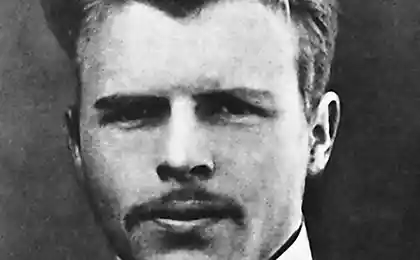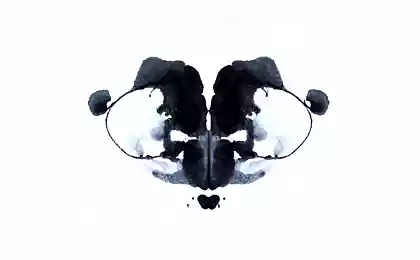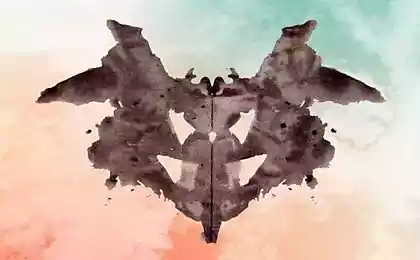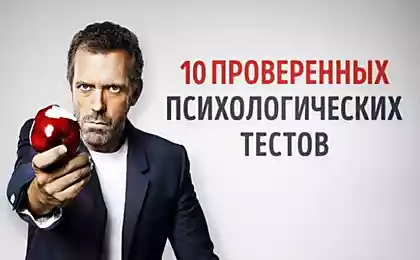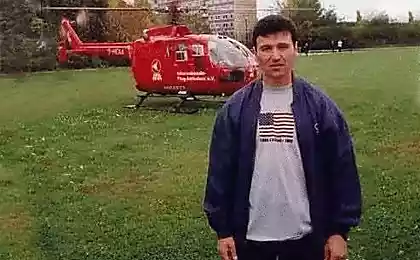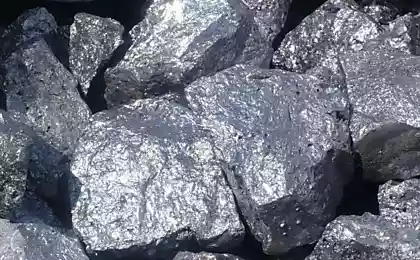948
How does a Rorschach test and who was its author
Personality rights and ink pyatna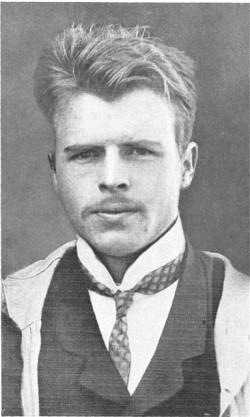
Hermann Rorschach was born November 8, 1884 in Zurich (Switzerland). He was the eldest son of the unfortunate artist, forced to make a living drawing lessons at school. Herman admired since childhood color spots (likely the result of the creative efforts of his father and the boy's own love for painting) and school friends called him blots. When Germany was twelve, his mother died, and when the young man was eighteen, died and his father. Graduated with honors from high school, Rorschach decided to study medicine. In 1912 he received his Doctor of Medicine, University of Zurich, then worked in a number of psychiatric hospitals. In 1911, while studying at the university, Rorschach has held a number of interesting experiments to verify whether the different artistic talents gifted students more imaginative in their interpretation of the common ink stains. This study had a huge impact not only on the future career of the scientist, but also on the development of psychology as a science in general. I must say, Rorschach was not the first to use in their studies color spots, but his experiment they were first used as part of an analytical approach. Results of the first experiment, scientists have been lost over time, but over the next ten years Rorschach conducted large-scale research and develop a systematic methodology to psychologists define personality types of people using conventional ink stains. Thanks to the work in a psychiatric hospital researcher had free access to its patients. Thus, Rorschach spent learning how to mentally ill people, and emotional health, which allowed him to develop a systematic test with ink stains, that can be used to analyze the personal characteristics of the person, determine the type of his personality and, if necessary, correct it.
In 1921, Rorschach has presented the results of its large-scale labor world, published a book called "Psycho." In it the author set out his theory of the personality characteristics of people. One of the key provisions is that the identity of each person represented qualities such as introversion and extroversion - in other words, that we are motivated by both external and internal factors. According to the scientist, test ink blots to evaluate the relative proportion of these properties and to identify any mental disorder or, in contrast, the strengths of the individual. Psychological research community virtually no attention to the first edition of Rorschach, since at the time the opinion prevailed that can not be measured nor test of what constitutes a person's identity. But over time, colleagues began to realize the benefit of Rorschach test, and in 1922 the psychiatrist discussed the possibility of improving his technique at a meeting of the Psychoanalytic Society. Unfortunately, the April 1, 1922, a week tormented severe abdominal pain, Hermann Rorschach was admitted to hospital with suspected appendicitis, April 2 died of peritonitis. He was only thirty-seven years, and he never saw the huge success he had invented a psychological tool.
Ink stains RorshahaV Rorschach inkblot used ten: five black and white, two black and red and three colored. Psychologist showing cards in a strict sequence, by asking the patient to the same question: "What's it like?". Once the patient saw all the pictures and the answers given, the psychologist again shows the card again in a strict sequence. The patient is asked to name all that he sees them, exactly where the picture he sees this or that way, and that it makes him give this answer. Cards can turn, tilt and manipulate in any other way. The psychologist must accurately record all the patient says and does during the test, and the time of each response. Further answers are analyzed and counted points. Then, by mathematical calculation shows the result according to the test, which is interpreted by a specialist. If any ink stain does not cause a person any associations or he can not describe, that it sees, it can mean that the images on the card an object in his mind is blocked, or that an image on it due to his subconscious with the theme that at the moment he did not want to discuss.
Card 1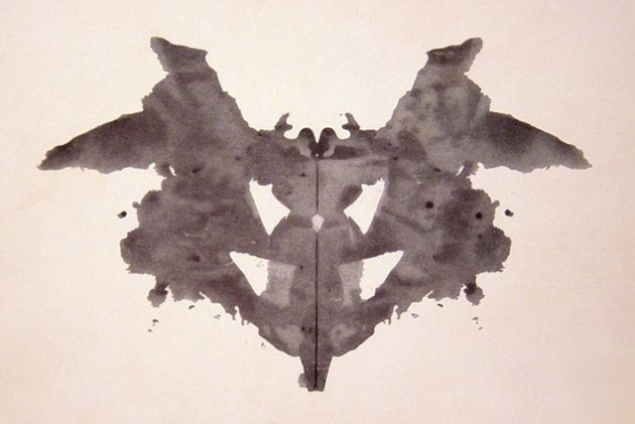
The first card we see a spot of black ink. Her first show, and the response to it allows the psychologist to suggest how the person performs a new job for him - hence, associated with a particular stress. Usually people say that the picture reminds them bat, moth, butterfly or snout of an animal such as an elephant or a rabbit. The answer reflects the type of person the respondent as a whole.
For some people, the image of the bat is associated with something unpleasant and even demonic; for others it is a symbol of rebirth, and the ability to navigate in the dark. Butterflies can symbolize the transition and transformation, as well as the ability to grow, to change, to overcome difficulties. Mole symbolizes the feeling of abandonment and ugliness, as well as weakness and anxiety. The muzzle of the animal, especially the elephant symbolizes the ways in which we confront the difficulties and the fear of domestic problems. It can also mean "an elephant in a china shop", that is to transmit a feeling of discomfort, and point out some problems from which people currently trying to get rid of.
Card 2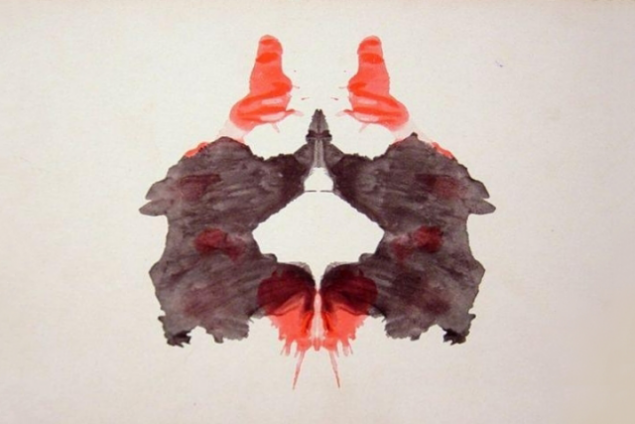
This card shows a spot of red and black, and people often see it as something sexual. Parts of the red is usually interpreted as blood, and the reaction to it shows how people manage their feelings and anger and how to deal with physical damage. Respondents often say that the spot reminds them of the act of pleading, two people, a man staring in the mirror, or some long-legged animal, such as a dog, bear or elephant.
If a person sees in the spot between two people, it can symbolize the interdependence, obsession with sex, ambivalent attitude to sex or focus on communication and close relationships with others. If the stain reminds reflected in the mirror of man, it can symbolize self-centeredness or, conversely, the tendency to self-criticism. Each of the two variants is expressed, or the negative or the positive characteristics of the individual, depending on what makes sense human image. If the person sees in the spot the dog, it could mean that he is a loyal and loving friend. If he sees a spot as something negative - so it needs to meet face to face with their fears and recognize their inner feelings. If you spot an elephant resembles a man, it can symbolize a tendency to meditation, developed intelligence and a good memory; Sometimes, however, this vision says about the negative perception of their own body. Bear, embodied in the spot symbolizes aggression, competition, independence and defiance. In the case of English-speaking patients can play the role of a play on words: bear (bear) and bare (stripped), which means that the sense of insecurity, vulnerability and sincerity and honesty in charge. A spot on this card reminds about something sexual and if the respondent sees it as a praying person, this may indicate attitudes toward sex in the context of religion. If the respondent sees the blood stains - so it is associated with religion, or physical pain, experiencing complex emotions like anger, resorts to prayer, or anger associated with religion.
Card 3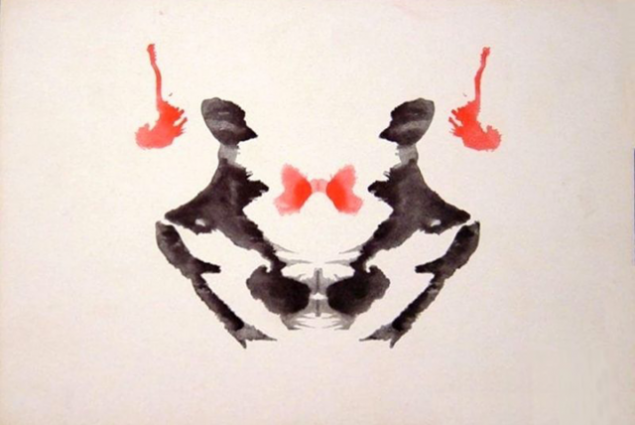
The third card shows a spot of red and black ink, and it symbolizes the perception of the patient's attitude to other people as part of social interaction. Most often, the respondents see in it the image of two people looking into the mirror of man, a butterfly or moth.
If a person sees two diners in a spot of people - this means that he leads an active social life. Spot resembling two, washing hands, says insecurity, a sense of ownership of the sewage or paranoia. If the respondent saw two people in the spot, playing some kind of game, it often indicates that he takes a position in social interactions opponent. If the stain is like a man staring at her reflection in the mirror, it can speak of self-centeredness, lack of attention to others and an inability to understand people.
Card 4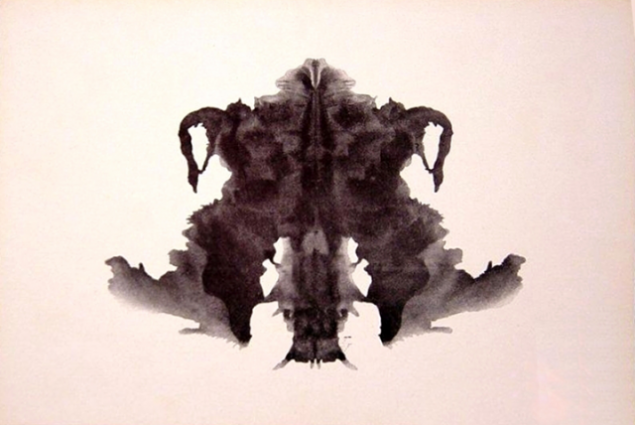
The fourth card experts call "father." The spot on her black, and some parts of the fuzzy, blurry. Many see in this picture something big and frightening - an image that is not usually perceived as a female and as a male. The response to this spot reveals a person's attitude to the authorities, and especially of his upbringing. The most common spot reminds respondents huge animal or a monster or a burrow of an animal or its pelt.
If the patient sees in the spot a large animal or a monster, it can symbolize a sense of inferiority and admiration for the authorities, as well as an exaggerated fear of people in positions of authority, including in front of his father. If the stain is responsible resembles the skin of an animal, it often represents the strongest internal discomfort in discussing topics related to the father. However, this may indicate that the problem of inferiority or the worship of authority is irrelevant for this respondent.
Card 5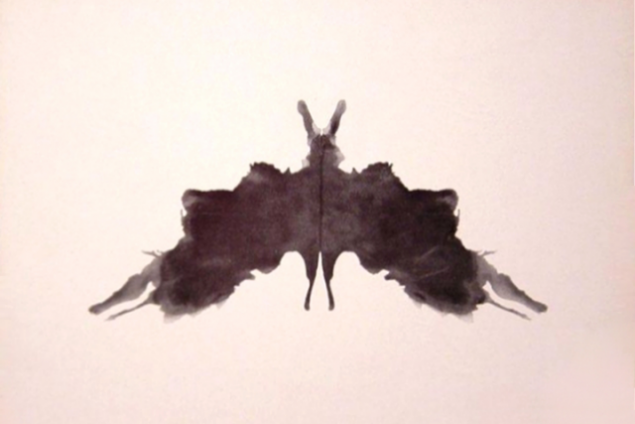
On this card, we again see a black spot. Association due to them, as well as an image on the first card shows our true "I". Looking at this picture, people usually do not feel threatened, but as the previous card gives them a completely different emotion, this time a person does not feel special stress or discomfort - hence, it is characterized by deeply personal reaction. If the image seen is very different from the response in the form of the first card, it means that the card with the second through fourth most likely produced on a large impression. Most often, this image reminds people bat, butterfly or moth.
Card 6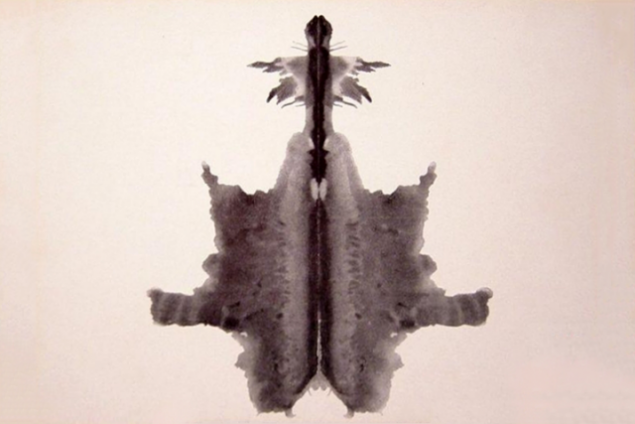
The picture on this card, too monochromatic, black; it is distinguished by texture spots. This image is a man of association with interpersonal intimacy, so it is called "sex card". Most people say that the spot reminds them burrow or animal skin, which may indicate a reluctance to enter into a relationship with others and, as a consequence, a sense of inner emptiness and isolation from society.
Card 7
A spot on this card is also black, and it is generally associated with the feminine. Because people often see in this spot images of women and children, it is called "mother". If a person is having difficulty with the description shown on the card - it may indicate that in his life develop complex relationships with women. Respondents often say that the spot reminds them of the head or face women or children; it can also bring back memories of the kiss.
If the spot seems like the heads of women, it symbolizes the feelings associated with the mother in charge, and that impact on his attitude to the female sex in general. If the stain recalls children's heads, it symbolizes the feelings associated with childhood and the need to care for a child who lives in the soul of the respondent, or the fact that the relationship with the mother of a patient in need of immediate attention and possibly corrected. If a person sees in the spot two heads, leaning in for a kiss, it speaks of his desire to be loved and to be reunited with his mother and that he seeks to reproduce the once close relationship with her mother in other relationships, including romantic or social.
Card 8
On this card there are gray and pink, and orange, and blue. It is not only the first multi-colored card in the test, it is also particularly difficult to interpret. If it is in its display or change the tempo display images respondent feels uncomfortable with - it is very likely that in the life he has difficulty with the processing of complex situations or emotional stimuli. Most people say they see here quadruped, a butterfly or moth.
Card 9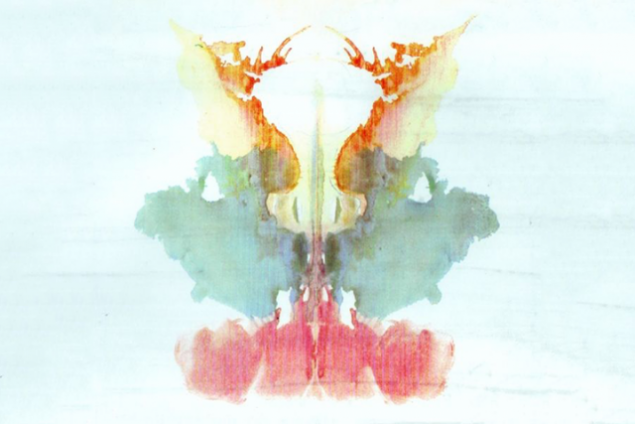
A spot on this card includes green, pink and orange. It has a vague outline, so it is difficult for most people to understand that it resembles the image. For this reason, this card allows you to assess how well a person copes with the lack of a clear structure and uncertainty. Most often, patients see her, or the general shape of a man, or some vague form of evil.
If you see the person in charge, the feelings experienced during this pass, how well it copes with a lack of organization and time information. If the stain resembles an abstract image of evil, it may indicate that a person needs a sense of comfort that his life had a clear schedule, and that it is bad to cope with uncertainty.
Card 10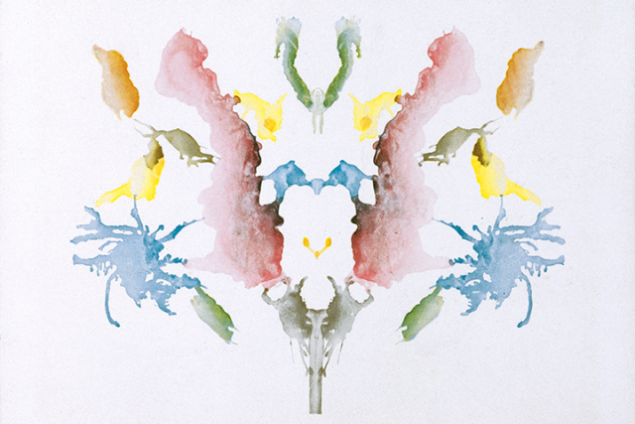
The last card Rorschach most colors and there is orange, and yellow, and green, and pink, and gray, and blue. In form it is somewhat similar to the eighth card, but more in line with the complexity of the ninth. Many people have pretty good feelings at the sight of this card, with the exception of those who were very puzzled by the complexity of determining the image shown on the previous card; when you look at this picture, they feel the same way. This may indicate that they find it difficult to cope with similar, simultaneous or overlapping incentives. Most people see on this card crab, lobster, spider, rabbit head, snakes or caterpillars.
The image symbolizes the tendency of respondents crab too much attached to things and people, or is the quality of tolerance. If a person sees the image of lobster, it may speak of his power, tolerance and ability to deal with minor issues, as well as the fear of harm to themselves or suffer the damage caused by someone else. If the stain resembles a spider, it can be a symbol of fear, feeling that a person by force or deception pulled into a difficult situation. In addition, the image of the spider symbolized too much care and nurturing mother and the power of women. If a person sees a rabbit's head, it may symbolize the reproductive ability and a positive attitude to life. The snakes represent the sense of danger or a feeling that a person had been deceived, and the fear of the unknown. Snakes are also often regarded as a phallic symbol, and are associated with inappropriate or forbidden sexual desires. Since this is the last card in the test if the patient sees her tracks, it speaks about the prospects of growth and understanding that people are constantly changing and evolving.
via vozduh.afisha.ru/books/kak-rabotaet-test-rorshaha-i-kem-byl-ego-avtor/

Hermann Rorschach was born November 8, 1884 in Zurich (Switzerland). He was the eldest son of the unfortunate artist, forced to make a living drawing lessons at school. Herman admired since childhood color spots (likely the result of the creative efforts of his father and the boy's own love for painting) and school friends called him blots. When Germany was twelve, his mother died, and when the young man was eighteen, died and his father. Graduated with honors from high school, Rorschach decided to study medicine. In 1912 he received his Doctor of Medicine, University of Zurich, then worked in a number of psychiatric hospitals. In 1911, while studying at the university, Rorschach has held a number of interesting experiments to verify whether the different artistic talents gifted students more imaginative in their interpretation of the common ink stains. This study had a huge impact not only on the future career of the scientist, but also on the development of psychology as a science in general. I must say, Rorschach was not the first to use in their studies color spots, but his experiment they were first used as part of an analytical approach. Results of the first experiment, scientists have been lost over time, but over the next ten years Rorschach conducted large-scale research and develop a systematic methodology to psychologists define personality types of people using conventional ink stains. Thanks to the work in a psychiatric hospital researcher had free access to its patients. Thus, Rorschach spent learning how to mentally ill people, and emotional health, which allowed him to develop a systematic test with ink stains, that can be used to analyze the personal characteristics of the person, determine the type of his personality and, if necessary, correct it.
In 1921, Rorschach has presented the results of its large-scale labor world, published a book called "Psycho." In it the author set out his theory of the personality characteristics of people. One of the key provisions is that the identity of each person represented qualities such as introversion and extroversion - in other words, that we are motivated by both external and internal factors. According to the scientist, test ink blots to evaluate the relative proportion of these properties and to identify any mental disorder or, in contrast, the strengths of the individual. Psychological research community virtually no attention to the first edition of Rorschach, since at the time the opinion prevailed that can not be measured nor test of what constitutes a person's identity. But over time, colleagues began to realize the benefit of Rorschach test, and in 1922 the psychiatrist discussed the possibility of improving his technique at a meeting of the Psychoanalytic Society. Unfortunately, the April 1, 1922, a week tormented severe abdominal pain, Hermann Rorschach was admitted to hospital with suspected appendicitis, April 2 died of peritonitis. He was only thirty-seven years, and he never saw the huge success he had invented a psychological tool.
Ink stains RorshahaV Rorschach inkblot used ten: five black and white, two black and red and three colored. Psychologist showing cards in a strict sequence, by asking the patient to the same question: "What's it like?". Once the patient saw all the pictures and the answers given, the psychologist again shows the card again in a strict sequence. The patient is asked to name all that he sees them, exactly where the picture he sees this or that way, and that it makes him give this answer. Cards can turn, tilt and manipulate in any other way. The psychologist must accurately record all the patient says and does during the test, and the time of each response. Further answers are analyzed and counted points. Then, by mathematical calculation shows the result according to the test, which is interpreted by a specialist. If any ink stain does not cause a person any associations or he can not describe, that it sees, it can mean that the images on the card an object in his mind is blocked, or that an image on it due to his subconscious with the theme that at the moment he did not want to discuss.
Card 1

The first card we see a spot of black ink. Her first show, and the response to it allows the psychologist to suggest how the person performs a new job for him - hence, associated with a particular stress. Usually people say that the picture reminds them bat, moth, butterfly or snout of an animal such as an elephant or a rabbit. The answer reflects the type of person the respondent as a whole.
For some people, the image of the bat is associated with something unpleasant and even demonic; for others it is a symbol of rebirth, and the ability to navigate in the dark. Butterflies can symbolize the transition and transformation, as well as the ability to grow, to change, to overcome difficulties. Mole symbolizes the feeling of abandonment and ugliness, as well as weakness and anxiety. The muzzle of the animal, especially the elephant symbolizes the ways in which we confront the difficulties and the fear of domestic problems. It can also mean "an elephant in a china shop", that is to transmit a feeling of discomfort, and point out some problems from which people currently trying to get rid of.
Card 2

This card shows a spot of red and black, and people often see it as something sexual. Parts of the red is usually interpreted as blood, and the reaction to it shows how people manage their feelings and anger and how to deal with physical damage. Respondents often say that the spot reminds them of the act of pleading, two people, a man staring in the mirror, or some long-legged animal, such as a dog, bear or elephant.
If a person sees in the spot between two people, it can symbolize the interdependence, obsession with sex, ambivalent attitude to sex or focus on communication and close relationships with others. If the stain reminds reflected in the mirror of man, it can symbolize self-centeredness or, conversely, the tendency to self-criticism. Each of the two variants is expressed, or the negative or the positive characteristics of the individual, depending on what makes sense human image. If the person sees in the spot the dog, it could mean that he is a loyal and loving friend. If he sees a spot as something negative - so it needs to meet face to face with their fears and recognize their inner feelings. If you spot an elephant resembles a man, it can symbolize a tendency to meditation, developed intelligence and a good memory; Sometimes, however, this vision says about the negative perception of their own body. Bear, embodied in the spot symbolizes aggression, competition, independence and defiance. In the case of English-speaking patients can play the role of a play on words: bear (bear) and bare (stripped), which means that the sense of insecurity, vulnerability and sincerity and honesty in charge. A spot on this card reminds about something sexual and if the respondent sees it as a praying person, this may indicate attitudes toward sex in the context of religion. If the respondent sees the blood stains - so it is associated with religion, or physical pain, experiencing complex emotions like anger, resorts to prayer, or anger associated with religion.
Card 3

The third card shows a spot of red and black ink, and it symbolizes the perception of the patient's attitude to other people as part of social interaction. Most often, the respondents see in it the image of two people looking into the mirror of man, a butterfly or moth.
If a person sees two diners in a spot of people - this means that he leads an active social life. Spot resembling two, washing hands, says insecurity, a sense of ownership of the sewage or paranoia. If the respondent saw two people in the spot, playing some kind of game, it often indicates that he takes a position in social interactions opponent. If the stain is like a man staring at her reflection in the mirror, it can speak of self-centeredness, lack of attention to others and an inability to understand people.
Card 4

The fourth card experts call "father." The spot on her black, and some parts of the fuzzy, blurry. Many see in this picture something big and frightening - an image that is not usually perceived as a female and as a male. The response to this spot reveals a person's attitude to the authorities, and especially of his upbringing. The most common spot reminds respondents huge animal or a monster or a burrow of an animal or its pelt.
If the patient sees in the spot a large animal or a monster, it can symbolize a sense of inferiority and admiration for the authorities, as well as an exaggerated fear of people in positions of authority, including in front of his father. If the stain is responsible resembles the skin of an animal, it often represents the strongest internal discomfort in discussing topics related to the father. However, this may indicate that the problem of inferiority or the worship of authority is irrelevant for this respondent.
Card 5

On this card, we again see a black spot. Association due to them, as well as an image on the first card shows our true "I". Looking at this picture, people usually do not feel threatened, but as the previous card gives them a completely different emotion, this time a person does not feel special stress or discomfort - hence, it is characterized by deeply personal reaction. If the image seen is very different from the response in the form of the first card, it means that the card with the second through fourth most likely produced on a large impression. Most often, this image reminds people bat, butterfly or moth.
Card 6

The picture on this card, too monochromatic, black; it is distinguished by texture spots. This image is a man of association with interpersonal intimacy, so it is called "sex card". Most people say that the spot reminds them burrow or animal skin, which may indicate a reluctance to enter into a relationship with others and, as a consequence, a sense of inner emptiness and isolation from society.
Card 7

A spot on this card is also black, and it is generally associated with the feminine. Because people often see in this spot images of women and children, it is called "mother". If a person is having difficulty with the description shown on the card - it may indicate that in his life develop complex relationships with women. Respondents often say that the spot reminds them of the head or face women or children; it can also bring back memories of the kiss.
If the spot seems like the heads of women, it symbolizes the feelings associated with the mother in charge, and that impact on his attitude to the female sex in general. If the stain recalls children's heads, it symbolizes the feelings associated with childhood and the need to care for a child who lives in the soul of the respondent, or the fact that the relationship with the mother of a patient in need of immediate attention and possibly corrected. If a person sees in the spot two heads, leaning in for a kiss, it speaks of his desire to be loved and to be reunited with his mother and that he seeks to reproduce the once close relationship with her mother in other relationships, including romantic or social.
Card 8

On this card there are gray and pink, and orange, and blue. It is not only the first multi-colored card in the test, it is also particularly difficult to interpret. If it is in its display or change the tempo display images respondent feels uncomfortable with - it is very likely that in the life he has difficulty with the processing of complex situations or emotional stimuli. Most people say they see here quadruped, a butterfly or moth.
Card 9

A spot on this card includes green, pink and orange. It has a vague outline, so it is difficult for most people to understand that it resembles the image. For this reason, this card allows you to assess how well a person copes with the lack of a clear structure and uncertainty. Most often, patients see her, or the general shape of a man, or some vague form of evil.
If you see the person in charge, the feelings experienced during this pass, how well it copes with a lack of organization and time information. If the stain resembles an abstract image of evil, it may indicate that a person needs a sense of comfort that his life had a clear schedule, and that it is bad to cope with uncertainty.
Card 10

The last card Rorschach most colors and there is orange, and yellow, and green, and pink, and gray, and blue. In form it is somewhat similar to the eighth card, but more in line with the complexity of the ninth. Many people have pretty good feelings at the sight of this card, with the exception of those who were very puzzled by the complexity of determining the image shown on the previous card; when you look at this picture, they feel the same way. This may indicate that they find it difficult to cope with similar, simultaneous or overlapping incentives. Most people see on this card crab, lobster, spider, rabbit head, snakes or caterpillars.
The image symbolizes the tendency of respondents crab too much attached to things and people, or is the quality of tolerance. If a person sees the image of lobster, it may speak of his power, tolerance and ability to deal with minor issues, as well as the fear of harm to themselves or suffer the damage caused by someone else. If the stain resembles a spider, it can be a symbol of fear, feeling that a person by force or deception pulled into a difficult situation. In addition, the image of the spider symbolized too much care and nurturing mother and the power of women. If a person sees a rabbit's head, it may symbolize the reproductive ability and a positive attitude to life. The snakes represent the sense of danger or a feeling that a person had been deceived, and the fear of the unknown. Snakes are also often regarded as a phallic symbol, and are associated with inappropriate or forbidden sexual desires. Since this is the last card in the test if the patient sees her tracks, it speaks about the prospects of growth and understanding that people are constantly changing and evolving.
via vozduh.afisha.ru/books/kak-rabotaet-test-rorshaha-i-kem-byl-ego-avtor/
